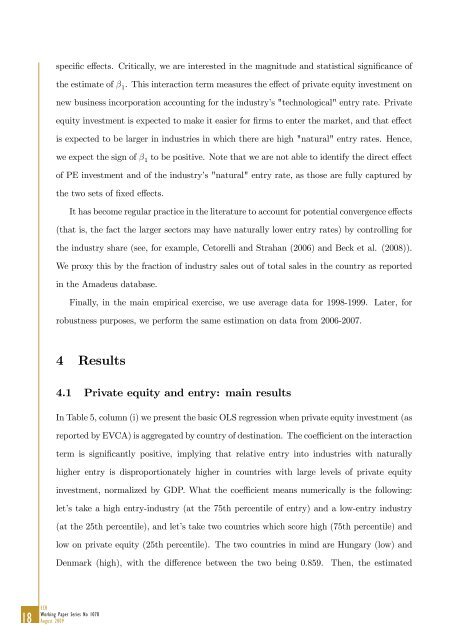On the real effects of private equity investment: evidence from new ...
On the real effects of private equity investment: evidence from new ...
On the real effects of private equity investment: evidence from new ...
- No tags were found...
Create successful ePaper yourself
Turn your PDF publications into a flip-book with our unique Google optimized e-Paper software.
speci…c e¤ects. Critically, we are interested in <strong>the</strong> magnitude and statistical signi…cance <strong>of</strong><strong>the</strong> estimate <strong>of</strong> 1 . This interaction term measures <strong>the</strong> e¤ect <strong>of</strong> <strong>private</strong> <strong>equity</strong> <strong>investment</strong> on<strong>new</strong> business incorporation accounting for <strong>the</strong> industry’s "technological" entry rate. Private<strong>equity</strong> <strong>investment</strong> is expected to make it easier for …rms to enter <strong>the</strong> market, and that e¤ectis expected to be larger in industries in which <strong>the</strong>re are high "natural" entry rates. Hence,we expect <strong>the</strong> sign <strong>of</strong> 1 to be positive. Note that we are not able to identify <strong>the</strong> direct e¤ect<strong>of</strong> PE <strong>investment</strong> and <strong>of</strong> <strong>the</strong> industry’s "natural" entry rate, as those are fully captured by<strong>the</strong> two sets <strong>of</strong> …xed e¤ects.It has become regular practice in <strong>the</strong> literature to account for potential convergence e¤ects(that is, <strong>the</strong> fact <strong>the</strong> larger sectors may have naturally lower entry rates) by controlling for<strong>the</strong> industry share (see, for example, Cetorelli and Strahan (2006) and Beck et al. (2008)).We proxy this by <strong>the</strong> fraction <strong>of</strong> industry sales out <strong>of</strong> total sales in <strong>the</strong> country as reportedin <strong>the</strong> Amadeus database.Finally, in <strong>the</strong> main empirical exercise, we use average data for 1998-1999. Later, forrobustness purposes, we perform <strong>the</strong> same estimation on data <strong>from</strong> 2006-2007.4 Results4.1 Private <strong>equity</strong> and entry: main resultsIn Table 5, column (i) we present <strong>the</strong> basic OLS regression when <strong>private</strong> <strong>equity</strong> <strong>investment</strong> (asreported by EVCA) is aggregated by country <strong>of</strong> destination. The coe¢ cient on <strong>the</strong> interactionterm is signi…cantly positive, implying that relative entry into industries with naturallyhigher entry is disproportionately higher in countries with large levels <strong>of</strong> <strong>private</strong> <strong>equity</strong><strong>investment</strong>, normalized by GDP. What <strong>the</strong> coe¢ cient means numerically is <strong>the</strong> following:let’s take a high entry-industry (at <strong>the</strong> 75th percentile <strong>of</strong> entry) and a low-entry industry(at <strong>the</strong> 25th percentile), and let’s take two countries which score high (75th percentile) andlow on <strong>private</strong> <strong>equity</strong> (25th percentile). The two countries in mind are Hungary (low) andDenmark (high), with <strong>the</strong> di¤erence between <strong>the</strong> two being 0.859.Then, <strong>the</strong> estimated18 ECBWorking Paper Series No 1078August 2009















